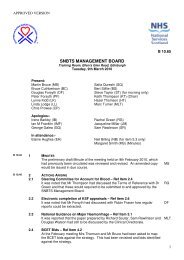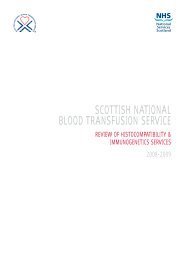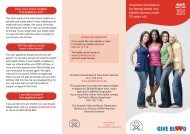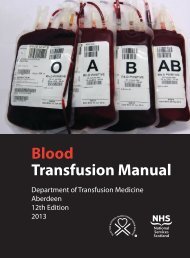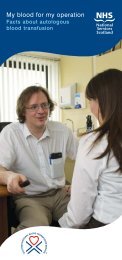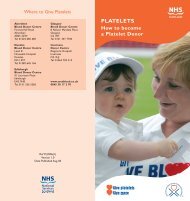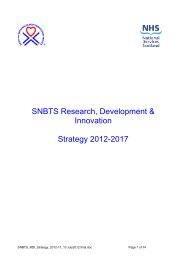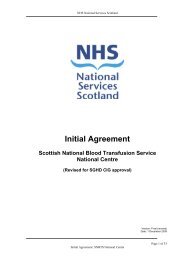Pregnant Women with Red Cell Antibodies - Scottish National Blood ...
Pregnant Women with Red Cell Antibodies - Scottish National Blood ...
Pregnant Women with Red Cell Antibodies - Scottish National Blood ...
Create successful ePaper yourself
Turn your PDF publications into a flip-book with our unique Google optimized e-Paper software.
<strong>Pregnant</strong> <strong>Women</strong><br />
<strong>with</strong> <strong>Red</strong> <strong>Cell</strong> <strong>Antibodies</strong>:<br />
<strong>Scottish</strong> <strong>National</strong> Clinical Guidance<br />
Electronic version available for download at SNBTS website:<br />
www.scotblood.co.uk/about-us/publications.aspx
Table of Contents<br />
Introduction ........................................................................................................................1<br />
1. Risk Assessment ................................................................................................................2<br />
1.1 History ......................................................................................................................2<br />
1.2 Maternal Screening ...................................................................................................2<br />
1.3 Paternal Testing .......................................................................................................3<br />
1.4 Free fetal DNA testing ..............................................................................................3<br />
2. Monitoring ......................................................................................................................5<br />
2.1 Antibody levels .........................................................................................................5<br />
Table 1: Antibody quantification (D, c) and risk of HDFN ...........................................5<br />
2.2 Ultrasound and Middle Cerebral Artery Peak Systolic Velocity (MCA PSV) Doppler ....5<br />
2.2.1 The fetus at moderate or high risk of HDFN .....................................................6<br />
2.2.2 The fetus at lower risk of HDFN ........................................................................6<br />
3. Intra-uterine Transfusion ...................................................................................................7<br />
3.1 Criteria for discussion <strong>with</strong> FMU Glasgow..................................................................7<br />
3.2 Intra-Uterine Transfusion ...........................................................................................7<br />
4. Delivery ............................................................................................................................8<br />
4.1 Delivery Plan .............................................................................................................8<br />
4.2 On admission in labour or for delivery .......................................................................8<br />
4.3 At Delivery ................................................................................................................8<br />
4.4 Post delivery .............................................................................................................9<br />
5. Communication & Documentation .................................................................................10<br />
5.1 <strong>Pregnant</strong> <strong>Women</strong> <strong>with</strong> <strong>Red</strong> <strong>Cell</strong> <strong>Antibodies</strong> Record of Care .....................................10<br />
5.2 The <strong>Pregnant</strong> Woman .............................................................................................10<br />
5.3 <strong>Blood</strong> Transfusion Laboratory ..................................................................................10<br />
5.4 Neonatal Team .......................................................................................................11<br />
5.5 FMU Glasgow .........................................................................................................11<br />
References ..........................................................................................................................12<br />
Appendices .........................................................................................................................13<br />
Appendix 1: Flow Chart Summarising Clinical Care for <strong>Pregnant</strong> <strong>Women</strong><br />
<strong>with</strong> red <strong>Cell</strong> <strong>Antibodies</strong> ..........................................................................14<br />
Appendix 2: <strong>Red</strong> <strong>Cell</strong> <strong>Antibodies</strong> and Risk of HDFN .....................................................15<br />
Appendix 3: Free Fetal DNA test request form .............................................................16<br />
Appendix 4: Reference Range of Fetal Middle Cerebral Artery Peak Systolic Velocity ....17<br />
Appendix 5: Specification of blood components for IUT ..............................................18<br />
List of Abbreviations ...........................................................................................................19<br />
Useful Contact Details .........................................................................................................20<br />
List of Contributors .............................................................................................................21<br />
Acknowledgements ............................................................................................................21<br />
i | Version 2, July 2013 | <strong>Pregnant</strong> <strong>Women</strong> <strong>with</strong> <strong>Red</strong> <strong>Cell</strong> <strong>Antibodies</strong>: <strong>Scottish</strong> <strong>National</strong> Clinical Guidance
Introduction<br />
The aim of this guideline is to outline best practice in the management of pregnant women in whom<br />
red cell antibodies are identified.<br />
There are three main reasons for testing for blood group and red cell antibodies during pregnancy:<br />
1. To ensure prior knowledge of blood group and identify any red cell antibodies that may make the<br />
cross-matching of blood for transfusion difficult.<br />
2. To identify Rh D negative mothers in order to determine those who require anti-D prophylaxis.<br />
3. To ensure early awareness of any red cell antibodies that have the potential to result in fetal/<br />
neonatal anaemia and/or associated Haemolytic Disease of the Fetus and Newborn (HDFN)*.<br />
* For the purposes of this guidance, the term ‘HDFN’ is used throughout, although in the context of<br />
an anti-K antibody the anaemia may not be solely haemolytic in nature (see section 2.1).<br />
Optimal care of pregnant women <strong>with</strong> red cell antibodies may involve healthcare professionals<br />
from several disciplines (General Practice, Obstetrics, Midwifery, Neonatology and the Transfusion<br />
Laboratory). This guidance is aimed at all members of the multidisciplinary team that may be involved<br />
in the care of these women.<br />
Timely and accurate communication between all those involved is essential to ensure the<br />
best outcome for mother and child. To facilitate communication and documentation, a<br />
‘Record of Care’ document has been developed in parallel <strong>with</strong> this guidance. An electronic<br />
version of both this guidance and the handheld record of care are available for download at:<br />
www.scotblood.co.uk/about-us/publications.aspx<br />
Guidance Development Process<br />
A multidisciplinary working group representing the <strong>Scottish</strong> <strong>National</strong> <strong>Blood</strong> Transfusion Service, the<br />
Ian Donald Fetal Medicine Unit, Healthcare Improvement Scotland and midwives, obstetricians and<br />
laboratory staff from across NHS Scotland was formed. The group worked collaboratively to review<br />
services and identify key issues concerning the care of pregnant women <strong>with</strong> red cell antibodies. Draft<br />
versions of this guidance, a flow chart of clinical care and hand held record of care were developed<br />
iteratively by the group and then the documents were peer reviewed by a wider group of professionals<br />
including obstetricians, midwives, paediatricians and transfusion specialists. The final documents were<br />
formally endorsed by Healthcare Improvement Scotland.<br />
A full list of contributors is given on Page 20.<br />
1 | Version 2, July 2013 | <strong>Pregnant</strong> <strong>Women</strong> <strong>with</strong> <strong>Red</strong> <strong>Cell</strong> <strong>Antibodies</strong>: <strong>Scottish</strong> <strong>National</strong> Clinical Guidance
1. Risk Assessment<br />
The approach to the management of women <strong>with</strong> red cell antibodies is guided by a risk assessment<br />
based on the history of fetal or neonatal manifestations and application of available diagnostic tools.<br />
Generally first affected pregnancies have clinically minimal HDFN, but subsequent pregnancies may be<br />
associated <strong>with</strong> a worsening degree of anaemia, but all women should have a formal risk assessment<br />
carried out.<br />
Any woman found, or already known to have red cell antibodies, should be considered as having ‘<strong>Red</strong>’<br />
status as per the <strong>National</strong> Pathways of Maternity Care, and have maternity team (obstetric led) care.<br />
Assessment by an obstetrician <strong>with</strong> expertise in the management of such women should take place at<br />
the earliest possible gestation. Ideally pre-conception counselling should be available for those women<br />
<strong>with</strong> previously identified red cell antibodies who are considering another pregnancy.<br />
1.1 History<br />
A comprehensive history of all previous pregnancies, whether affected or not, should be taken. In<br />
particular, previous intra-uterine transfusion (IUT), neonatal anaemia and need for exchange transfusion<br />
and/or phototherapy should be noted.<br />
Using suitable discretion and privacy, attempt to establish whether the father of this pregnancy is the<br />
same as that of any previously affected pregnancy (ies).<br />
If there is history of a previously affected and/or treated pregnancy, for example where IUT or neonatal<br />
treatment were required, the clinical course is often more severe in subsequent pregnancies. Early<br />
intervention may be appropriate and it is considered good practice to discuss all such cases <strong>with</strong> the<br />
Fetal Medicine Unit (FMU) at the Southern General Hospital in Glasgow at an early stage of pregnancy<br />
in order to establish a clear management plan.<br />
An assessment of the maternal risk for major haemorrhage should be made as suitable blood for<br />
maternal transfusion may be difficult to source. If there is an increased likelihood maternal haemorrhage<br />
e.g. placenta praevia, previous postpartum haemorrhage or maternal anaemia, inform your local blood<br />
transfusion laboratory and the relevant SNBTS Regional <strong>Blood</strong> Transfusion Centre (RTC) as soon as<br />
possible (See Pg19 for further information and contact details).<br />
1.2 Maternal Screening<br />
A sample for maternal blood group and red cell antibody screen should be undertaken at as early<br />
a gestation as possible. Please ensure that all samples are appropriately labelled as per the<br />
requirements for transfusion samples to avoid rejection of the sample by the transfusion<br />
laboratory and delay in initiating appropriate management. Subsequent investigation and fetal<br />
monitoring depends on the type and level of antibody (ies) present (See flow chart, Appendix 1, and<br />
this guidance).<br />
<strong>Red</strong> cell antibodies are found in around one percent of pregnancies. Up to 30% of clinically significant<br />
antibodies occur for the first time in the third trimester. Almost every clinically significant red cell<br />
antibody has been implicated in causing variable degrees of HDFN. However, the commonest cause of<br />
significant HDFN is anti-D, although the incidence of this is decreasing due to the routine use of anti-D<br />
immunoglobulin prophylaxis. The other two main causes of significant HDFN are anti-c and anti-K,<br />
followed by anti-E, anti-Kidd (Jk) and anti-Duffy (Fy) antibodies. Other red cell antibodies can cause<br />
HDFN, although this is generally mild (See Appendix 2).<br />
It is recommended that all women have a sample taken for ABO group and Rh(D) type and red cell<br />
antibody screening at the time of booking. If the woman is Rh(D) negative and has not been sensitised<br />
to the D-antigen (i.e. does not have immune anti-D present) she is eligible for anti-D prophylaxis,<br />
2 | Version 2, July 2013 | <strong>Pregnant</strong> <strong>Women</strong> <strong>with</strong> <strong>Red</strong> <strong>Cell</strong> <strong>Antibodies</strong>: <strong>Scottish</strong> <strong>National</strong> Clinical Guidance
irrespective of the presence of other red cell antibodies. Where anti-D and /or anti-c is present, the<br />
sample will be sent to the SNBTS West of Scotland (WoS) RTC at Gartnavel, Glasgow for antibody<br />
quantification (see section 2.1).<br />
British Committee for Standards in Haematology (BCSH) guidelines suggest that antibody testing be<br />
performed at the time of booking and at 28 weeks gestation. If anti-D, anti-c or anti-K antibodies are<br />
detected the frequency of testing should be increased to monthly until 28 weeks and then fortnightly<br />
until delivery (see section 2.1).<br />
NB: When writing ‘anti-c’ by hand, it is good practice to annotate it as anti-c to differentiate it from<br />
anti-C.<br />
1.3 Paternal Testing<br />
Confidential counselling should be used to establish that the woman is certain of the paternity of this<br />
baby, and if the father would be available and willing to provide a blood sample to ascertain the likely<br />
blood group of the baby for the purposes of risk assessment (see below).<br />
Paternal blood group and red cell phenotype should be determined where possible when antibodies<br />
that are associated <strong>with</strong> a risk of HDFN are present:<br />
If the father’s phenotype indicates that he is antigen negative: The fetus cannot have the antigen of interest<br />
and therefore cannot be affected by maternal antibody to that antigen. Care for this pregnancy should<br />
continue as for a non-sensitised pregnancy. If an antibody of another specificity develops further risk<br />
assessment and care should be initiated as per this guidance.<br />
If the father’s phenotype indicates that he is antigen positive: Paternal zygosity must be determined to<br />
estimate the risk of the fetus having the antigen(s) of interest.<br />
If the paternal phenotype suggests the father is homozygous for the antigen of interest: The fetus must<br />
carry the relevant antigen(s) and therefore can be affected by maternal antibody to that antigen. The<br />
fetus is considered ‘at risk’ and care should be as per flow chart (Appendix 1) and this guidance. Free<br />
fetal DNA testing is not required.<br />
If the paternal phenotype suggests that the father is heterozygous for the antigen(s) of interest: The fetus<br />
may, or may not, carry the relevant antigen (s); free fetal DNA testing is required to establish the risk<br />
of the fetus having the antigen(s) of interest (See section 1.4).<br />
If there is any uncertainty, or if the father of the baby is unwilling or unable to provide a blood sample,<br />
use free fetal DNA testing instead of paternal testing where available (see section 1.4 for information<br />
on free fetal DNA testing).<br />
The process for requesting paternal testing will vary locally. Check <strong>with</strong> the local laboratory before taking<br />
the sample. The form accompanying such samples must clearly indicate the origin of the sample, the<br />
relationship to the woman <strong>with</strong> antibodies and the woman’s name, date of birth and CHI or hospital<br />
number.<br />
1.4 <strong>Cell</strong> Free Fetal DNA testing<br />
Fetal red cell antigen status for D, C, c, E, and Kell (K) can be predicted by analysing cell free fetal<br />
(cff) DNA present in maternal plasma. This is known as ‘Non-invasive prenatal diagnosis’, or NIPD.<br />
The amount of cff DNA shed into the maternal circulation increases throughout pregnancy. There is<br />
considerable individual variation in the levels of cff DNA present in the maternal plasma. If there is<br />
insufficient cff DNA present, i.e. below the sensitivity of the real time PCR DNA assay, an inconclusive<br />
NIPD result may occur and a repeat maternal sample will be requested at a later gestation, usually in<br />
2-4 weeks time.<br />
3 | Version 2, July 2013 | <strong>Pregnant</strong> <strong>Women</strong> <strong>with</strong> <strong>Red</strong> <strong>Cell</strong> <strong>Antibodies</strong>: <strong>Scottish</strong> <strong>National</strong> Clinical Guidance
RHD, RHC, RHE genotyping<br />
The earliest time point for reliable fetal Rh genotyping is 12 wks gestation, The optimum time point, if<br />
there is no clinical urgency, is ≥ 16wks gestation.<br />
KEL genotyping<br />
The earliest time point for reliable fetal KEL genotyping is currently 16 wks gestation. The optimum<br />
time point, if there is no clinical urgency, is ≥ 16wks gestation.<br />
RHc genotyping<br />
The earliest time point for reliable fetal RHc genotyping is 18 wks gestation. Due to the specific molecular<br />
basis of the Rhc DNA PCR assay, often fetal RHc NIPD results are inconclusive and will require repeat<br />
testing 2-4 weeks later.<br />
<strong>Cell</strong> free fetal DNA testing is indicated when:<br />
• Anti-D, c, C, E or K is present, and<br />
•<br />
•<br />
The father is heterozygous or not available for phenotyping, and<br />
Antibody titre and /or quantification are not informative.<br />
NIPD testing is undertaken by the Molecular Immunohaematology Reference Laboratory at the North<br />
East (NE) Scotland Regional Transfusion Centre in Aberdeen. It is essential that the consultant in charge<br />
is contacted to discuss the case BEFORE sending a sample to ensure the most efficient testing strategy.<br />
The NIPD request form must be fully completed including relevant clinical details, full transfusion<br />
history/ laboratory investigations <strong>with</strong> contact information for the referring clinical team and local<br />
transfusion laboratory. The sample tubes and form must meet the expected labelling standards for<br />
patient identification as for a transfusion sample (Appendix 3: NIPD request form). Samples should be<br />
sent by 1st class post, avoiding weekends and public holidays.<br />
The laboratory needs to receive the outcome of the pregnancy i.e. the cord blood serology to conclude<br />
NIPD cases and meet the requirements of their external quality assessment scheme.<br />
Clinical implication of NIPD test results<br />
If cff DNA testing suggests that the fetus is antigen positive: the fetus is ‘at risk’ of HDFN, and care<br />
should be as per flow chart (Appendix 1) and this guidance.<br />
If paternal phenotyping and / or cff DNA testing is not possible, provide care as if the fetus is antigen<br />
positive.<br />
If cff DNA testing suggests that the fetus is antigen negative: the fetus is ‘not at risk’ and care<br />
should be as in a non-sensitised pregnancy.<br />
NB: If a negative result is obtained for the allele of interest, and the presence of fetal DNA cannot be<br />
demonstrated, a repeat sample will be requested for confirmation of that negative result before final<br />
reporting.<br />
NB: Occasional ‘false’ negative results have been reported using cff DNA, if further routine antibody<br />
testing suggests a rising antibody level, consider the possibility that the fetus may in fact be antigen<br />
positive and monitor as per care of sensitised pregnancy as per flow chart.<br />
4 | Version 2, July 2013 | <strong>Pregnant</strong> <strong>Women</strong> <strong>with</strong> <strong>Red</strong> <strong>Cell</strong> <strong>Antibodies</strong>: <strong>Scottish</strong> <strong>National</strong> Clinical Guidance
2. Monitoring<br />
2.1 Antibody levels<br />
Antibody levels are usually expressed as titres e.g. 1 in 4, 1 in 8, 1 in 64 etc. These figures represent<br />
doubling dilutions where an aliquot of neat plasma is diluted <strong>with</strong> an equal volume of normal saline to<br />
give a dilution of 1 in 2; an aliquot of this diluted plasma is then diluted again <strong>with</strong> an equal volume<br />
of saline to give a dilution of 1 in 4, and so on. Each dilution is tested for the presence of antibody<br />
until the antibody is no longer detectable in the diluted plasma. The reported titre of an antibody is the<br />
weakest concentration of plasma at which the antibody can still be detected. Therefore there is more<br />
maternal antibody, and therefore more clinical concern, for a titre of 1 in 64 than a titre of 1 in 4. Titres<br />
of >1 in 32 are usually taken as an indication for antenatal assessment (see section 2.2.1).<br />
NB: In addition to causing haemolysis, anti-K antibody can also bind to red cell precursors in the<br />
bone marrow, suppressing fetal erythropoiesis, and contributing to fetal anaemia. Thus significant fetal<br />
anaemia may arise in the presence of lower levels of anti-K antibody. Therefore the presence of anti-K<br />
at a titre of 1 in 8 is interpreted as ‘high risk’.<br />
Titres, while useful in monitoring the overall trend in an antibody level, are open to some variation<br />
between operators. A semi-automatic technique giving more reproducible results is available for anti-D<br />
and anti-c quantification. Antibody quantification results are expressed as international units per millilitre<br />
(iu/ml). There is good correlation between low levels of antibody and a benign outcome; however,<br />
the outcome is more unpredictable at higher levels as the degree of haemolysis is also dependent<br />
on other aspects of the antibody: IgG sub-class, efficiency of placental transfer, density of fetal red<br />
cell antigens, efficiency of clearance of antibody-coated red cells by the fetal spleen etc. The level of<br />
antibody is therefore only an indication that more direct assessment of the fetus is required. Antibody<br />
(D, c) quantification results guiding clinical management are shown in Table 1. All quantification tests<br />
are performed by the WoS RTC in Glasgow.<br />
Table 1: Antibody quantification (D, c) and risk of HDFN<br />
Level of Risk for HDFN<br />
Antibody Result (iu/ml)<br />
Anti-D<br />
Anti-c<br />
Low 0-4 0-7.5<br />
Moderate 4-15 7.5-20<br />
High Greater than 15 Greater than 20<br />
British Committee for Standards in Haematology (2006)<br />
Where an antibody level, whether measured by titre or by quantification, indicates moderate risk of<br />
HDFN, and gestation has reached 18 weeks, clinicians should consider further investigation / assessment<br />
using Middle Cerebral Artery Peak Systolic Velocity (MCA PSV) Doppler scanning. If the antibody level<br />
suggests ‘high risk’ MCA PSV Doppler scanning should be undertaken as soon as is practical in order to<br />
determine the presence and severity of fetal anaemia. If antibody levels exceed the high risk thresholds<br />
at less than 18 weeks gestation, then referral to the FMU in Glasgow is indicated.<br />
5 | Version 2, July 2013 | <strong>Pregnant</strong> <strong>Women</strong> <strong>with</strong> <strong>Red</strong> <strong>Cell</strong> <strong>Antibodies</strong>: <strong>Scottish</strong> <strong>National</strong> Clinical Guidance
2.2 Ultrasound and Middle Cerebral Artery Peak Systolic Velocity (MCA PSV)<br />
Doppler<br />
MCA PSV Doppler Scanning should be performed by a suitably trained person and the result interpreted<br />
by a clinician <strong>with</strong> expertise in the management of HDFN.<br />
2.2.1 The fetus at moderate or high risk of HDFN<br />
When antibody levels or obstetric history indicate moderate or high risk of HDFN (Table 1), prediction<br />
of fetal anaemia should be based on MCA Doppler assessment. MCA peak systolic velocities (PSV) of<br />
>1.5 Multiples of the Median (MoM) have good predictive value for moderate to severe anaemia (see<br />
Appendix 4). As anaemia can develop rapidly, regular monitoring, at least fortnightly, is suggested.<br />
MCA PSV Doppler Scanning is indicated if:<br />
•<br />
•<br />
•<br />
•<br />
•<br />
Anti-D antibody quantification continues to rise above 4 iu/ml<br />
Anti-c antibody quantification continues to rise above 7.5 iu/ml<br />
Anti-K antibody present at titre 1 in 8<br />
Any other antibody present at titre 1 in 32<br />
There is history of previously affected/treated pregnancy<br />
Discussion <strong>with</strong> the FMU in Glasgow is indicated if:<br />
• MCA PSV exceeds 1.5 MoM<br />
•<br />
•<br />
Antibody levels exceed the thresholds stated at less than 18 weeks gestation<br />
MCA PSV is in normal range, but there are ultrasonographic features suggestive of anaemia (e.g.<br />
ascites, pleural effusions, hydrops, placentomegaly)<br />
• MCA PSV is not available locally<br />
MCA PSV Doppler Scanning is less sensitive for prediction of fetal anaemia beyond 35 weeks gestation.<br />
Decisions regarding timing of delivery should also take into account history, antibody level and MCA<br />
PSV trend. If in doubt, please discuss <strong>with</strong> FMU Glasgow and neonatology.<br />
2.2.2 The fetus at lower risk of HDFN<br />
MCA Doppler is not indicated if maternal antibodies are present at levels below the thresholds outlined<br />
above (Table 1).<br />
In all cases continue to monitor the antibody screen, as outlined in section 1.2, to detect increase in<br />
antibody level and any new red cell antibody formation. The development of additional antibodies<br />
may alter the fetal monitoring regime and must be considered when providing appropriate (antigen<br />
negative) blood suitable for transfusion to mother or baby should the need arise.<br />
Referral to FMU Glasgow is indicated if there are ultrasonographic features suggestive of anaemia (e.g.<br />
ascites, pleural effusions, hydrops, placentomeagly)<br />
6 | Version 2, July 2013 | <strong>Pregnant</strong> <strong>Women</strong> <strong>with</strong> <strong>Red</strong> <strong>Cell</strong> <strong>Antibodies</strong>: <strong>Scottish</strong> <strong>National</strong> Clinical Guidance
3. Intra-uterine Transfusion<br />
Intervention using IUT is aimed at maintaining fetal haemoglobin at a level sufficient to prevent the<br />
adverse effects of anaemia and ultimately the development of hydrops. IUT is a highly specialised<br />
technique that in Scotland is only performed at the FMU in Glasgow. Any woman at risk of requiring<br />
an IUT should be discussed <strong>with</strong> their clinicians.<br />
3.1 Criteria for discussion <strong>with</strong> FMU Glasgow<br />
Individual cases should be discussed <strong>with</strong> FMU Glasgow if the fetus is known to be at high risk of HDFN<br />
(through paternal and/or genetic testing), or fetal risk is unknown, and there is:<br />
• History of a previously affected / treated pregnancy<br />
•<br />
Antibody level suggestive of moderate or high risk of HDFN and MCA PSV not available at referring<br />
maternity unit<br />
• MCA Doppler PSV exceeds 1.5 MoM<br />
• Ultrasound evidence of fetal anaemia<br />
The discussion will determine whether it is appropriate for the woman to attend FMU Glasgow or to<br />
continue attending the referring maternity unit <strong>with</strong> an agreed plan of care. If in doubt, please call the<br />
FMU Glasgow to discuss individual cases.<br />
3.2 Intra-Uterine Transfusion<br />
On referral to FMU Glasgow women will be assessed and IUT offered if appropriate.<br />
If IUT is being considered the transfusion laboratory at the Southern General Hospital and the WoS<br />
RTC should be informed as soon as possible to allow them to source and make available suitable blood<br />
for transfusion. Please note that blood for IUT has a high specification and may require some time to<br />
organise, especially if rare blood types are involved as donors may need to be called specifically (see<br />
Appendix 5 for the specification of blood components for IUT).<br />
After 26 weeks gestation, steroids are usually given prior to IUT due to the increased risk of premature<br />
delivery. The need for steroids should be discussed at time of referral.<br />
IUT is not usually performed after 34 weeks. If there is a sudden and significant rise in antibody level<br />
after this gestation, discuss individual care and potential delivery <strong>with</strong> FMU Glasgow.<br />
If IUT is required FMU Glasgow will liaise <strong>with</strong> the relevant referring maternity unit to schedule delivery<br />
for 36-38 weeks at a unit <strong>with</strong> neonatal intensive care facilities.<br />
If an IUT is performed, it is important that the clinical team and the blood bank at any other hospital<br />
that may be involved in the subsequent care of the woman and her baby is informed of this occurrence.<br />
Any neonate who has received an IUT will require irradiated blood for exchange or top up transfusion<br />
following delivery. This requirement must be recognised and specifically requested by those providing<br />
care for the neonate.<br />
7 | Version 2, July 2013 | <strong>Pregnant</strong> <strong>Women</strong> <strong>with</strong> <strong>Red</strong> <strong>Cell</strong> <strong>Antibodies</strong>: <strong>Scottish</strong> <strong>National</strong> Clinical Guidance
4. Delivery<br />
4.1 Delivery Plan<br />
The delivery plan <strong>with</strong>in the record of care should be completed as soon as is practical. Delivery would<br />
normally be spontaneous or by induction of labour if there are no contraindications. There is usually no<br />
additional need for elective caesarean section. The delivery should take place in a location <strong>with</strong> facilities<br />
for neonatal intensive care. The neonatal team should also be involved in drawing up the delivery plan.<br />
<strong>Women</strong> who have received IUT: delivery as above, following discussion <strong>with</strong> FMU Glasgow.<br />
If no IUT has been necessary:<br />
Fetus at moderate or high risk, but MCA PSV less than 1.5MoM: Deliver by 38 weeks.<br />
<strong>Women</strong> <strong>with</strong> previous significant HDFN, but <strong>with</strong> MCA PSV less than 1.5 MoM: Discuss <strong>with</strong> FMU Glasgow<br />
and deliver by 38 weeks.<br />
<strong>Women</strong> <strong>with</strong> anti-K < 1 in 8, anti-D
4.4 Post delivery<br />
The newborn infant may require phototherapy, top up transfusion or exchange transfusion depending<br />
on the degree of haemolysis and/or anaemia present. Neonates who have required IUT will have<br />
suppressed erythropoiesis and are likely to require top up transfusion and on occasions require<br />
erythropoeitin treatment. <strong>Blood</strong> for exchange or top up transfusion must be irradiated if there has<br />
been a prior IUT.<br />
Babies born to mothers <strong>with</strong> red cell antibodies may be at risk of severe hyperbilirubinaemia in the<br />
neonatal period, even where there were no signs of fetal complications during pregnancy. Liaison<br />
between obstetric and neonatal teams should take place around time of delivery and during the<br />
neonatal period.<br />
The mother should be counselled regarding the risks for future pregnancies. The need for early<br />
assessment and ideally pre-natal counselling should be emphasised.<br />
9 | Version 2, July 2013 | <strong>Pregnant</strong> <strong>Women</strong> <strong>with</strong> <strong>Red</strong> <strong>Cell</strong> <strong>Antibodies</strong>: <strong>Scottish</strong> <strong>National</strong> Clinical Guidance
5. Communication & Documentation<br />
5.1 <strong>Pregnant</strong> <strong>Women</strong> <strong>with</strong> <strong>Red</strong> <strong>Cell</strong> <strong>Antibodies</strong> Record of Care<br />
A handheld record of care, for use alongside the SWHMR Pregnancy Record, has<br />
been developed to compliment this guidance. Copies are available to download at:<br />
www.scotblood.co.uk/about-us/publications.aspx<br />
The record of care should be commenced as soon as is practical after the discovery of red cell antibodies.<br />
All relevant care, investigations and treatment should be documented in the record. The record should<br />
be held by the woman and brought to each appointment or assessment.<br />
The delivery plan <strong>with</strong>in the record of care should be completed as soon as is practical.<br />
The attending paediatrician should document observations and planned neonatal management on the<br />
delivery plan following initial assessment of the newborn.<br />
The outcome form should be completed as soon as is practical. The information collected will be used<br />
for auditing and to monitor trends in incidence and outcomes of pregnancies where red cell antibodies<br />
are present.<br />
It is suggested that a distribution list is created at the time of booking to enable prompt and inclusive<br />
communication regarding the care of women <strong>with</strong> red cell antibodies. This can be used to share<br />
relevant results of investigations and management plans between the members of the multidisciplinary<br />
team providing care. This list should include as an initial minimum the GP, midwife, obstetrician,<br />
paediatrician and laboratory manager involved in the care of the woman. If a referral is made to a<br />
specialist obstetric unit, the names of the obstetrician, midwife and laboratory manager involved at<br />
that institution should be added to the list. If the woman is referred to the FMU in Glasgow, the name<br />
of the obstetrician, mid wife and laboratory manager at the Southern General Hospital in Glasgow<br />
should be added. If at any time samples are sent to the WoS RTC or the NE Scotland RTC in Aberdeen,<br />
the name of the relevant laboratory manager should be added.<br />
5.2 The <strong>Pregnant</strong> Woman<br />
The pregnant woman should be fully involved in all decisions regarding her care and treatment. She<br />
should be made aware of the significance of her handheld record of care, particularly when care is<br />
provided by two or more maternity units. A patient information leaflet on red cell antibodies is available<br />
and can be downloaded from www.scotblood.co.uk/about-us/publications.aspx<br />
5.3 <strong>Blood</strong> Transfusion Laboratory<br />
In common <strong>with</strong> the clinical services involved <strong>with</strong> the care of women <strong>with</strong> red cell antibodies, a number of<br />
blood transfusion laboratories in different locations may be involved in the care pathway.<br />
Local <strong>Blood</strong> Transfusion Laboratory:<br />
This is the hospital transfusion laboratory or blood bank at the booking maternity unit. This may also<br />
be one of the SNBTS regional transfusion laboratories.<br />
10 | Version 2, July 2013 | <strong>Pregnant</strong> <strong>Women</strong> <strong>with</strong> <strong>Red</strong> <strong>Cell</strong> <strong>Antibodies</strong>: <strong>Scottish</strong> <strong>National</strong> Clinical Guidance
SNBTS Regional <strong>Blood</strong> Transfusion Laboratories<br />
Region<br />
East of Scotland <strong>Blood</strong> Transfusion Centre, Dundee<br />
North of Scotland <strong>Blood</strong> Transfusion Centre, Inverness;<br />
NE Scotland <strong>Blood</strong> Transfusion Centre, Aberdeen<br />
SE Scotland <strong>Blood</strong> Transfusion Centre, Edinburgh;<br />
West of Scotland <strong>Blood</strong> Transfusion Centre, Glasgow<br />
<strong>National</strong> Services<br />
Fetal Genotyping<br />
Antibody Quantification<br />
<strong>Blood</strong> for IUT<br />
The hospital blood transfusion laboratories, in collaboration <strong>with</strong> SNBTS, will provide blood suitable<br />
for maternal, intra-uterine and/or neonatal transfusion as required. It is vital to ensure that the relevant<br />
transfusion laboratory where the episode of care is taking place is aware of the presence of the woman<br />
in their service area. Please inform the relevant local transfusion laboratory when:<br />
•<br />
A decision is made to transfuse (Maternal, IUT, neonatal top-up or exchange), or transfusion is<br />
likely<br />
• A decision is made on place and date of delivery<br />
•<br />
•<br />
Mother and/or neonate are transferred between maternity units<br />
This pregnancy ends in miscarriage, termination of pregnancy or stillbirth/intrauterine death.<br />
This is particularly important if arrangements have been made to call donors for anticipated<br />
transfusion needs and these are no longer required.<br />
Samples for blood grouping and antibody screen should be sent to the blood transfusion laboratory<br />
that usually processes samples for the clinical unit where the sample is taken. Any samples showing<br />
irregular antibodies will be forwarded by that laboratory to the appropriate regional blood transfusion<br />
laboratory for further testing. The regional laboratory will forward any samples that require antibody<br />
quantification to the WoS RTC Laboratory in Glasgow.<br />
Reporting of test results will be cascaded back through the sequence of laboratories in the same<br />
manner.<br />
<strong>Blood</strong> for IUT will be sourced and cross matched by the WoS RTC in Glasgow before being despatched<br />
to the blood bank at the Southern General Hospital, Glasgow for subsequent issue to the patient.<br />
5.4 Neonatal Team<br />
Liaise <strong>with</strong> the neonatal team who will care for the baby, and involve them in the discussion of the<br />
delivery plan. The paediatrician who assesses the newborn should document a plan of care.<br />
5.5 FMU Glasgow<br />
The specialist team at the FMU Glasgow are available to provide advice at any time. Please call to<br />
discuss general or specific queries.<br />
11 | Version 2, July 2013 | <strong>Pregnant</strong> <strong>Women</strong> <strong>with</strong> <strong>Red</strong> <strong>Cell</strong> <strong>Antibodies</strong>: <strong>Scottish</strong> <strong>National</strong> Clinical Guidance
References<br />
Guidelines for compatibility procedures in blood transfusion laboratories<br />
British Committee for Standards in Haematology<br />
Transfusion Medicine 2004 14 59-73<br />
Transfusion guidelines for neonates and older children<br />
British Committee for Standards in Haematology<br />
Br J Haem 124 433-453<br />
Transfusion guidelines for neonates and older children<br />
British Committee for Standards in Haematology<br />
Br J Haem 124 433-453<br />
Guidelines for the use of prophylactic anti-D immunoglobulin, 2008<br />
British Committee for Standards in Haematology<br />
www.transfusionguidelines.org<br />
G Daniels, J Poole, M de Silva et al<br />
The clinical significance of blood group antibodies<br />
Transfusion Medicine 2002 12 287-295<br />
Kenneth J Moise Jr<br />
<strong>Red</strong> <strong>Blood</strong> <strong>Cell</strong> Alloimmunisation in Pregnancy<br />
Seminars in Hematology, 2005<br />
Kenneth J Moise<br />
Fetal anaemia due to non-Rhesus-D red-cell alloimmunisation<br />
Seminars in Fetal & Neonatal Medicine, 2008 13 207-214<br />
Guideline for <strong>Blood</strong> Grouping and Antibody Testing in Pregnancy, 2006<br />
British Committee for Standards in Haematology<br />
www.transfusionguidelines.org<br />
12 | Version 2, July 2013 | <strong>Pregnant</strong> <strong>Women</strong> <strong>with</strong> <strong>Red</strong> <strong>Cell</strong> <strong>Antibodies</strong>: <strong>Scottish</strong> <strong>National</strong> Clinical Guidance
Appendices<br />
13 | Version 2, July 2013 | <strong>Pregnant</strong> <strong>Women</strong> <strong>with</strong> <strong>Red</strong> <strong>Cell</strong> <strong>Antibodies</strong>: <strong>Scottish</strong> <strong>National</strong> Clinical Guidance
Appendix 1:<br />
Flow Chart Summarising Clinical Care for <strong>Pregnant</strong> <strong>Women</strong> <strong>with</strong><br />
red <strong>Cell</strong> <strong>Antibodies</strong><br />
First Pregnancy or No Previous<br />
Pregnancy Affected by HDFN<br />
Identify antibody<br />
specificity, titre and/<br />
or quantification<br />
History of Previous Pregnancy<br />
Affected by HDFN<br />
Commence testing to<br />
determine risk to this fetus<br />
Risk of HDFN Low (see table below)<br />
Anti-c, D or K<br />
Any other<br />
antibody<br />
Risk of HDFN Moderate or High<br />
(see table below)<br />
Continue antibody testing:<br />
Monthly to 28 weeks then 2 weekly<br />
Paternal Phenotype*<br />
Continue<br />
antibody testing:<br />
Monthly to 28<br />
weeks then 2<br />
weekly**<br />
Delivery:<br />
By term<br />
Repeat antibody<br />
screening at 28<br />
weeks**<br />
Delivery:<br />
Await spontaneous<br />
labour<br />
Fetus Antigen Negative: NOT AT RISK<br />
Continue antibody screening as per<br />
Non-Sensitised Pregnancy<br />
(If an antibody of another specificity develops<br />
resume care as per flow chart above)<br />
NB: RhD negative women who do not have anti-D<br />
antibody should be given anti-D prophylaxis even<br />
if other red cell antibodies are present<br />
Father antigen<br />
negative<br />
Fetus Antigen<br />
Negative<br />
Paternal testing<br />
not possible<br />
Free Fetal DNA Testing*<br />
Testing Not<br />
Possible<br />
Fetus antigen positive or unknown<br />
& Moderate or High Risk<br />
(see table below)<br />
MCA Doppler from 18 weeks<br />
Repeat regularly (at least fortnightly)<br />
& Continue Antibody Testing<br />
monthly to 28 weeks then 2 weekly<br />
Father antigen<br />
positive<br />
Heterozygous<br />
Fetus Antigen<br />
Positive<br />
Homozygous<br />
Delivery: Await<br />
spontaneous<br />
labour<br />
MCA<br />
1.5MoM<br />
Or not available locally<br />
Contact FMU Glasgow<br />
for discussion, further assessment<br />
and/or Intra-Uterine Transfusion<br />
Delivery:<br />
As discussed <strong>with</strong> FMU Glasgow<br />
* Fetal and Paternal DNA testing will not be possible for some antibodies, the fetus should be considered ‘at risk’ in<br />
those cases<br />
** If antibody testing at any stage indicates a moderate or high risk of HDFN, then the care pathway for higher risk<br />
pregnancy should be followed thereafter<br />
Risk for Fetal<br />
Anaemia<br />
Antibody Specificity & Level<br />
Anti-D (iu/ml) Anti-c (iu/ml) Anti-K (Titre) Other antibody(ies) (Titre)<br />
Low 0-4 0-7.5 Less than 1in8 Less than 1in32<br />
Moderate 4-15 7.5-20 - -<br />
High 15 or above 20 or above 1in8 or above >1in32<br />
NB: The presence of any red cell antibody impacts significantly on provision of suitable blood for maternal transfusion. The<br />
hospital blood bank should always be made aware, as far in advance as possible, of planned delivery and/or admission in<br />
labour. <strong>Blood</strong> bank should also be informed if there is increased risk of maternal haemorrhage eg. placenta praevia.<br />
14 | Version 2, July 2013 | <strong>Pregnant</strong> <strong>Women</strong> <strong>with</strong> <strong>Red</strong> <strong>Cell</strong> <strong>Antibodies</strong>: <strong>Scottish</strong> <strong>National</strong> Clinical Guidance
Appendix 2:<br />
<strong>Red</strong> <strong>Cell</strong> <strong>Antibodies</strong> and Risk of HDFN<br />
<strong>Antibodies</strong> Frequently Associated <strong>with</strong> Severe Disease<br />
Antigen System<br />
Specific Antigen<br />
Kell<br />
-K (K1)<br />
Rh<br />
-c, D<br />
<strong>Antibodies</strong> Infrequently Associated <strong>with</strong> Severe Disease<br />
Antigen System<br />
Specific Antigen<br />
Colton<br />
-Coa -Co3<br />
Diego<br />
-ELO, -Dia, -Dib, -Wra, -Wrb<br />
Duffy<br />
-Fya<br />
Kell<br />
-Jsb, -k (k2), -Kpa, -Kpb, -K11, -K22, -Ku, -U1a<br />
Kidd<br />
-Jka<br />
MNS<br />
-Ena, -Far, -Hil, -Hut, -M, -Mia, -Mta, -MUT,<br />
-Mur, -Mv, -s, -sD, -S, -U, -Vw<br />
Rh<br />
-Bea, -C, -Ce, -Cw, -ce, -E, -Ew, -Evans, -G,<br />
-Goa, -Hr, -Hro, -JAL, -Rh32, -Rh42, -Rh46,<br />
-STEM, -Tar<br />
Scianna<br />
-Sc2, -Rd<br />
Other<br />
-Bi, -Good, -Heibel, -HJK, -Hta, -Jones, -Joslin,<br />
-Kg, -Kuhn, -Lia, -MAM, -Niemetz, -REIT,<br />
-Reiter, -Rd, -Sharp, -Vel, -Zd<br />
<strong>Antibodies</strong> Associated <strong>with</strong> Mild Disease<br />
Antigen System<br />
Specific Antigen<br />
Duffy<br />
-Fyb, -Fy3<br />
Gerbich<br />
-Ge2, -Ge3, -Ge4, -Lsa<br />
Kell<br />
-Jsa<br />
Kidd<br />
-Jkb, -Jk3<br />
MNS<br />
-Mit<br />
Rh<br />
-Cx, -Dw, -e, -HOFM, -LOCR, -Riv, -RH29<br />
Other<br />
-Ata, -JFV, -Jra, -Lan<br />
Moise KJ (2005), <strong>Red</strong> <strong>Blood</strong> <strong>Cell</strong> Alloimmunisation in Pregnancy, Seminars in Haematology<br />
15 | Version 2, July 2013 | <strong>Pregnant</strong> <strong>Women</strong> <strong>with</strong> <strong>Red</strong> <strong>Cell</strong> <strong>Antibodies</strong>: <strong>Scottish</strong> <strong>National</strong> Clinical Guidance
Appendix 3:<br />
Free Fetal DNA test request form<br />
Surname<br />
Maiden Name<br />
First Name<br />
Date of Birth<br />
Previous BTS Number<br />
CHI Number<br />
Hospital Unit Number<br />
Sample Date & Time<br />
Gestation (weeks)<br />
EDD<br />
Ethnic Origin of Patient<br />
<strong>Blood</strong> Group of Patient<br />
Surname<br />
First Name<br />
Date of Birth<br />
CHI / Hospital Unit No<br />
Ethnic Origin of Partner<br />
<strong>Blood</strong> Group of Partner<br />
Phenotype of Partner<br />
ABERDEEN & NE SCOTLAND BLOOD TRANSFUSION CENTRE<br />
Molecular Immunohaematology Reference Laboratory<br />
Request for Fetal Typing from Maternal <strong>Blood</strong> / Amniotic Fluid / CVS<br />
Patient Details Maternal <strong>Antibodies</strong> () Titre Quant.<br />
Partner details<br />
REASON FOR REQUEST / RELEVANT CLINICAL HISTORY::<br />
Consultant Responsible:<br />
(please attach copies of any relevant reports)<br />
REPORT DESTINATION:<br />
Anti-RhD<br />
Anti-RhC<br />
Anti-Rhc<br />
Anti-RhE<br />
Anti-K<br />
Other (please specify)<br />
RhD<br />
RhC<br />
Rhc<br />
RhE<br />
K (Kell)<br />
Other (please specify)<br />
Tests Requested ()<br />
Sample Type(s) enclosed ()<br />
Typing from maternal blood<br />
2 x 7mL EDTA blood from patient<br />
2 x 7mL EDTA blood from partner<br />
Typing from amniotic fluid / CVS<br />
10mL amniotic fluid / CVS<br />
7mL EDTA blood from patient and partner<br />
Name & Address of Requestor: [PLEASE PRINT]<br />
Name:<br />
Address:<br />
Email:<br />
Telephone:<br />
Signature:<br />
COPY REPORT DESTINATION(S):<br />
Please inform the Aberdeen <strong>Blood</strong> Bank prior to sending<br />
samples [01224 552322 / 552512 / 812474] Fax: 01224 662200<br />
Ship at room temperature.<br />
DO NOT SEND SAMPLES ON FRIDAYS<br />
Sample must arrive at the Aberdeen laboratory <strong>with</strong>in 48<br />
hours of being taken (1 st Class post preferred)<br />
PLEASE SEND SAMPLES TO:<br />
Molecular Immunohaematology Laboratory<br />
Aberdeen & NE Scotland <strong>Blood</strong> Transfusion Centre<br />
Foresterhill Road, ABERDEEN, AB25 2ZW<br />
E-mail: nss.MIHlab@nhs.net<br />
NEBTS LABORATORY USE ONLY<br />
Patient Traceline Partner Traceline Date & Time Received<br />
Sample No<br />
Sample No<br />
Patient Traceline ID No<br />
Partner Traceline ID No:<br />
Form<br />
MIH02.03<br />
16 | Version 2, July 2013 | <strong>Pregnant</strong> <strong>Women</strong> <strong>with</strong> <strong>Red</strong> <strong>Cell</strong> <strong>Antibodies</strong>: <strong>Scottish</strong> <strong>National</strong> Clinical Guidance
Appendix 4:<br />
Reference Range of Fetal Middle Cerebral Artery Peak Systolic<br />
Velocity<br />
Reference range of fetal middle cerebral artery peak systolic velocity (MCA-PSV) median<br />
and 1.5 multiples of the median (MoM) values during pregnancy<br />
Gestational Age (weeks)<br />
MCA-PSV (cm/s)<br />
Median<br />
1.5 MoM<br />
14 19.3 28.9<br />
15 20.2 30.3<br />
16 21.1 31.7<br />
17 22.1 33.2<br />
18 23.2 34.8<br />
19 24.3 36.5<br />
20 25.5 38.2<br />
21 26.7 40.0<br />
22 27.9 41.9<br />
23 29.3 43.9<br />
24 30.7 46.0<br />
25 32.1 48.2<br />
26 33.6 50.4<br />
27 35.2 52.8<br />
28 36.9 55.4<br />
29 38.7 58.0<br />
30 40.5 60.7<br />
31 42.4 63.6<br />
32 44.4 66.6<br />
33 46.5 69.8<br />
34 48.7 73.1<br />
35 51.1 76.6<br />
36 53.5 80.2<br />
37 56.0 84.0<br />
38 58.7 88.0<br />
39 61.5 92.2<br />
40 64.4 96.6<br />
Modified from G Mari et al. N Engl J Med 2000: 342: 9-14<br />
17 | Version 2, July 2013 | <strong>Pregnant</strong> <strong>Women</strong> <strong>with</strong> <strong>Red</strong> <strong>Cell</strong> <strong>Antibodies</strong>: <strong>Scottish</strong> <strong>National</strong> Clinical Guidance
Appendix 5:<br />
•<br />
•<br />
•<br />
Specification of blood components for IUT<br />
Donation must be from an accredited donor<br />
Group O or ABO identical <strong>with</strong> the fetus, and RhD negative in most cases<br />
Negative for the relevant antigen(s) determined by maternal antibody status and IAT cross-match<br />
compatible <strong>with</strong> maternal serum<br />
• K negative<br />
•<br />
•<br />
•<br />
•<br />
•<br />
•<br />
•<br />
In CPD, not SAG-M<br />
Used <strong>with</strong>in 5 days of collection<br />
Free from clinically significant antibodies including high-titre anti-A and anti-B<br />
CMV antibody negative<br />
Gamma irradiated and used <strong>with</strong>in 24 hours of irradiation<br />
Leucocyte depleted<br />
Haematocrit of > 0.7<br />
18 | Version 2, July 2013 | <strong>Pregnant</strong> <strong>Women</strong> <strong>with</strong> <strong>Red</strong> <strong>Cell</strong> <strong>Antibodies</strong>: <strong>Scottish</strong> <strong>National</strong> Clinical Guidance
List of Abbreviations<br />
ABO<br />
BBT<br />
CHI<br />
CMV<br />
CPD<br />
D C c E e<br />
DAT<br />
DNA<br />
FBC<br />
FMH<br />
FMU<br />
HDFN<br />
IAT<br />
iu<br />
IUD<br />
IUT<br />
K<br />
MCA<br />
ml<br />
MoM<br />
NE<br />
MCA PSV<br />
RTC<br />
RhD<br />
SAG-M<br />
SE<br />
SNBTS<br />
WoS<br />
ABO notation for the ABO blood group system<br />
Better <strong>Blood</strong> Transfusion<br />
Community Health Index<br />
Cytomegalovirus<br />
Citrate Phosphate Dextrose<br />
Antigens of the Rh blood group system<br />
Direct Antiglobulin Test<br />
Deoxyribonuecleic Acid<br />
Full <strong>Blood</strong> Count<br />
Feto-Maternal Haemorrhage<br />
Fetal Medicine Unit<br />
Haemolytic Disease of the Fetus & Newborn<br />
Indirect Antiglobulin Test<br />
International units<br />
Intra-Uterine Death<br />
Intra-Uterine transfusion<br />
K1 antigen of the Kell blood group system<br />
Middle Cerebral Artery<br />
Millilitre<br />
Multiples of Median<br />
North East<br />
Middle Cerebral Artery Peak Systolic Velocity<br />
Regional Transfusion Centre<br />
D antigen of the Rh blood group system<br />
Saline Adenine Glucose Mannitol<br />
South East<br />
<strong>Scottish</strong> <strong>National</strong> <strong>Blood</strong> Transfusion Service<br />
West of Scotland<br />
19 | Version 2, July 2013 | <strong>Pregnant</strong> <strong>Women</strong> <strong>with</strong> <strong>Red</strong> <strong>Cell</strong> <strong>Antibodies</strong>: <strong>Scottish</strong> <strong>National</strong> Clinical Guidance
Useful Contact Details<br />
Address<br />
Ian Donald Fetal Medicine Unit,<br />
Southern General Maternity Unit,<br />
1345 Govan Road,<br />
Glasgow, G51 4TF<br />
Molecular Immunohaematology Reference Laboratory,<br />
Aberdeen & NE Scotland Transfusion Centre,<br />
Foresterhill Road<br />
Aberdeen, AB25 2ZW<br />
West of Scotland <strong>Blood</strong> Transfusion Centre, Gartnavel<br />
25 Shelley Road<br />
Glasgow G12 0XB<br />
East of Scotland <strong>Blood</strong> Transfusion Centre<br />
Ninewells Hospital<br />
Dundee<br />
Edinburgh & South East <strong>Blood</strong> Transfusion Centre<br />
Edinburgh Royal Infirmary<br />
51 Little France Crescent<br />
Edinburgh EH16 4 SA<br />
North of Scotland <strong>Blood</strong> Transfusion Centre<br />
Raigmore Hospital<br />
Inverness<br />
<strong>Blood</strong> Transfusion Laboratory,<br />
Southern General Hospital,<br />
Glasgow<br />
Telephone<br />
0141 232 4339<br />
01224 685685<br />
0141 3577700<br />
01382 632953<br />
0131 2427501<br />
01463 704000<br />
0141 201 1597<br />
20 | Version 2, July 2013 | <strong>Pregnant</strong> <strong>Women</strong> <strong>with</strong> <strong>Red</strong> <strong>Cell</strong> <strong>Antibodies</strong>: <strong>Scottish</strong> <strong>National</strong> Clinical Guidance
List of Contributors<br />
Dr Anne Armstrong, Obstetric Registrar, Simpson Centre for Reproductive Health, Edinburgh<br />
Dr Karen Bailie, Consultant Haematologist, <strong>Scottish</strong> <strong>National</strong> <strong>Blood</strong> Transfusion Service, Gartnavel<br />
Hospital, Glasgow<br />
Professor Alan Cameron, Ian Donald Fetal Medicine Unit, Southern General hospital, Glasgow<br />
Mairi Harkness, Transfusion Specialist Midwife, Better <strong>Blood</strong> Transfusion, SNBTS, Edinburgh<br />
Gillian Kemp, BMS 2, <strong>Scottish</strong> <strong>National</strong> <strong>Blood</strong> Transfusion Service, Gartnavel Hospital, Glasgow<br />
Dr Christopher Lennox, Clinical Advisor, Reproductive Health Programme, Health Improvement<br />
Scotland / Consultant Obstetrician, Wishaw General Hospital, Wishaw<br />
Dr Sarah Stock, Clinical Lecturer/Subspeciality Trainee Maternal & Fetal Medicine, University of<br />
Edinburgh<br />
Dr Tony Thomas, Obstetric Registrar, Ian Donald Fetal Medicine Unit, Southern General Hospital,<br />
Glasgow<br />
Dr Graham Tydeman, Consultant in Obstetrics and Gynaecology, NHS Fife<br />
Sandra Whitelaw, Specialist Midwife, Ian Donald Fetal Medicine Unit, Southern General Hospital,<br />
Glasgow<br />
Acknowledgements<br />
Thank you to everyone who reviewed, commented on and contributed to the production of these<br />
guidelines.<br />
21 | Version 2, July 2013 | <strong>Pregnant</strong> <strong>Women</strong> <strong>with</strong> <strong>Red</strong> <strong>Cell</strong> <strong>Antibodies</strong>: <strong>Scottish</strong> <strong>National</strong> Clinical Guidance



